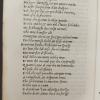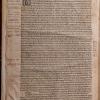A Renaissance Manuscript (MS Can. Ital. 101)
Commentary
A Renaissance Manuscript (MS Can. Ital. 101)
Oxford, Bodleian Library, MS Can. Ital. 101 (unit II)
Italy, 16th century
Italy, 16th century
Paper; ff. 48 + I; mm 206 x 150 (this codex is bound with a 15th-century copy of Giovanni Boccaccio’s Ninfale fiesolano); verses copied in a single column in a cursive script by two hands (the first hand only copies ff. 62v-64v, a quire probably added later; the second, principal hand is probably earlier). Copious marginal variant readings in the pages copied by the second hand, by this same scribe, derived from the source used for the text (M. Barbi, Studi sul Canzoniere di Dante, Firenze, Sansoni, 1915, 23-26). Some other marginal annotations by a much later hand.
Rubrics in brown ink.
18th-century binding, cardboard and leather.
Italy; Matteo Luigi Canonici, 1727–1805; Giuseppe Canonici , -1807; Bodleian Library (from 1817).
The manuscript contains two series of poems by Dante. One has just five poems, and precedes the other, written earlier and made up of 21 poems. Some of the texts are spurious.
This simple volume is an example of the late manuscript circulation of Dante’s lyric poetry. Compiled when Dante’s poems had already been printed at least once, it demonstrates the persistence of the manuscript medium well into the age of printing. Printed editions of Dante’s lyric poetry were not common, and lyric poetry was one of the genres that circulated widely in manuscripts during the Renaissance. What is more, the first printed edition of Dante’s lyrics (1491) was an appendix to a large, commented Commedia, while lyric poetry circulated in small books, both manuscripts and printed editions, which could be held in one hand. This was the format chosen by Aldo Manuzio for his editions of the Classics, as well as for both Dante’s Commedia (1502) and Petrarch’s Canzoniere (1501).


